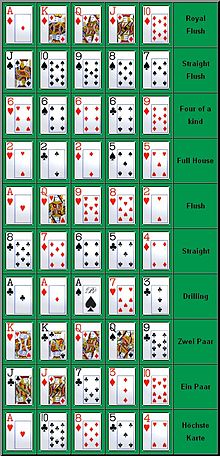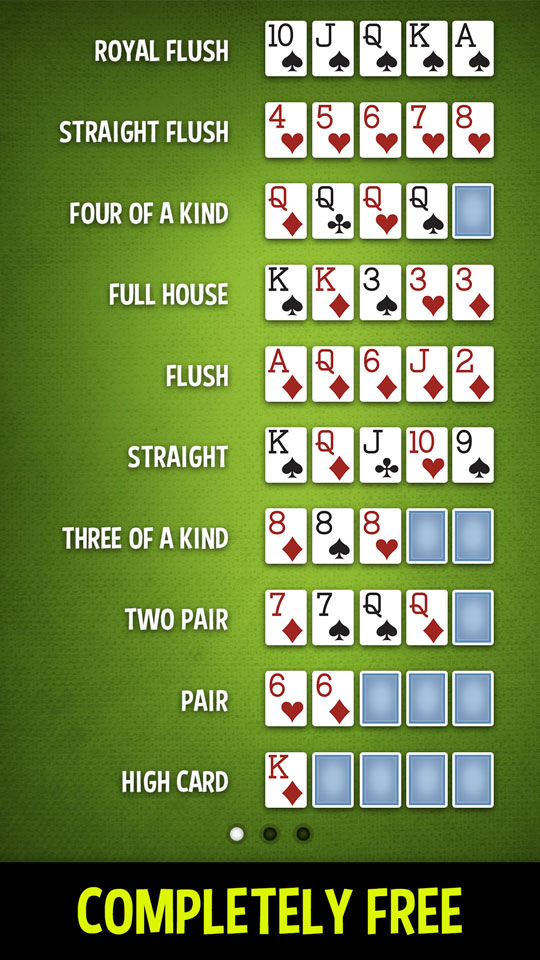Texas Holdem Hands Wiki


Texas hold 'em (also known as hold 'em or holdem) is a variation of the standard card game of poker. Texas hold 'em consists of two cards (hole cards) being dealt face down to each player and then five community cards being placed face-up by the dealer — a series of three ('the flop') then an additional single card ('the turn' or 'fourth') and another additional card ('the river' or 'fifth. In the poker game of Texas hold 'em, a starting hand consists of two hole cards, which belong solely to the player and remain hidden from the other players. Five community cards are also dealt into play. Betting begins before any of the community cards are exposed, and continues throughout the hand. Poker is any of a number of card games in which players wager over which hand is best according to that specific game's rules in ways similar to these rankings.Often using a standard deck, poker games vary in deck configuration, the number of cards in play, the number dealt face up or face down, and the number shared by all players, but all have rules which involve one or more rounds of betting.
Texas hold 'em (also hold'em, holdem) is the most popular poker game in the casinos and poker card rooms across North America and Europe, as well as online. According to Doyle Brunson and Johnny Moss, it was originally considered a variation of seven card stud, and was called 'Texas hold 'em seven card stud' back in the 1920's.
Texas hold'em is a popularversion of the cardgamepoker.
How to play[change change source]
Before any cards are dealt, two players to the left of the dealer make bets which are called the 'Small Blind' and 'Big Blind'. These forced bets must be at least matched by the other players in order to keep their hands. The big blind is twice as much as the small blind. If the big blind was $1000, then it is said that the blinds are 500 and 1000. This money is put into a place in the center of the table that is called the 'pot'
Each player is given two cards face down. These are called the player's 'Hole Cards' or what the player has 'in the hole'. Once all the players have their hole cards, the betting starts. The player to the left of the Big Blind player starts the betting. The lowest amount that can be bet is the amount of the big blind. Players can bet more than the minimum. This is called 'Raising'. The amount a player can raise is determined by the type of the game being played (see below) If a player raises, the amount he raised the bet to is the new minimum. Each player in turn may either 'Call' (pay the current bet amount), Raise, or 'Fold' (quit the hand). This action keeps going around the table until each player has called or folded his hand.
After the first turn of betting is over, the dealer lays three cards face up on the table. This is called the 'Flop'. These three cards are 'community cards'. This means they are used by every player in the game along with the two hole cards each player has. After the flop, another turn of betting takes place. There is no starting bet in this turn (no blinds) unless a player makes a bet. Players may 'Check' or bet nothing if no player before them in the turn has bet. If everyone checks, or if a player bets and all the others call or fold, then the round of betting is over.
Next the dealer lays another community card face up. This card is called 'the turn' (or 4th Street). Another series of betting comes after this. This betting is the same as after the Flop.
Finally the dealer lays the last community card known as 'the river' (or 5th Street). This card is again followed by a turn of betting, calling and folding by the players.
With the five community cards and their two hole cards, each player makes the best 5 card poker hand he can. The player with the best poker hand wins the round and the pot. If two or more players have the same hand, those players split the pot evenly. If one person bets and all other players have folded, the hand ends then and that player wins.

Styles of play[change change source]
Texas Hold'em can be played several ways, including Limit, Pot Limit and No Limit games. The version of the game usually is the maximum a player can raise at any one time.
Limit[change change source]
Texas Holdem Hands Wikipedia
Limit games have a set amount that a player can raise at any time. If a game has a $10 limit, then a raise must be exactly $10. If more than one person raises, each one can only raise $10 more than the last raise. Typically, there is a 'cap' of 3 raises per round. Also, when playing limit, the bet and raise amount will usually double for the turn and river betting rounds.
Example[change change source]
In a 4 player game, Player A bets $10. Player B raises $10 (puts in $20 total), Player C calls Player B (puts in $20). Player D at this point can either fold, pay $20 (call player B) or raise $10 to a total of $30. Player A would go next and either call (paying the difference between his $10 bet and the current bet). This would continue until all players either call or fold.
Pot Limit[change change source]
In Pot Limit games, the most a player can bet or raise is the total amount in the pot. With each bet or raise, the amount in the pot gets larger. This allows for larger raises.
Spread Limit[change change source]
In Spread Limit games, there is both a minimum and a maximum raise specified. For example, one could play $5–50 spread limit. The big blind would be $5 and the minimum raise would be $5 and the maximum raise would be $50.
No Limit[change change source]
In No Limit, there is not a limit of how much can be bet at any time. That is, it is just like Spread Limit, but with no maximum. A player can bet up to all money as he has. If a player bets all of his money, he is said to be 'All In'. If a player bets more money than another player has, the second player can call by going All In. If only those two players stay in the hand (all other players fold), the first player takes back any money that is over the amount the player going All In has. At this point, all betting stops and the dealer deals out the rest of the cards.
If a player goes All In and two or more players are still betting, the other betters can raise each other until they both call (or one of them also goes All In). A 'side pot' is made in this case. It is the difference between the final bet and the first person's All In. Only the two players were not All In can win this pot. If the All In player wins the hand, he wins the main pot (his money plus an equal amount from each other player) and which ever of the other two players had the better hand wins the side pot. In an eight player game, it is possible to have several side pots with several people being All In at the same time. If there are not two player left who can bet, betting stops and all players turn their hands over.
Example[change change source]
Player A bets $5000. Player B only has $3000. He goes All In. Player C Raises $2000 (puts in a total of $7000). Player A calls (puts in $2000). At this point, the main pot is worth $9000 ($3000 from each player). The side pot is worth $8000 ($7000–3000 from Players A and C)
Texas Hold'em Hands Wiki
If player A or C wins, he wins both the main pot and the side pot ($17,000) and Player B is out of the game since he is out of money. If player B wins, he wins the main pot and the side pot goes to which ever player has the best hand between players A and C.
Tournaments[change change source]
Tournaments are what people often see when poker is shown on television. When a player enters a tournament, he pays an entry fee called the 'buy-in.' Most of his buy-in is placed with other player's money in the prize pool. Usually, a small portion of the buy-in is kept by the tournament officials for their expenses (and profit). The player is given a table and seat assignment, and a certain number of chips - the same amount as every other player. Unlike normal chips, these tournament chips have no cash value (though they often are referred to with dollar amounts). Players must continue to play until they run out of chips. The tournament continues until one player has accumulated all of the chips. The order in which people lose all their chips (or 'bust out'), is their finishing order. That is, the last player to bust out is the second-place finisher. The prize pool is divided amongst a fraction of the top finishers (usually about 10%). The first-place winner usually gets a much larger share, with the prizes diminishing until the prize pool is empty. The player who was the last player to finish without winning any prize is said to have finished 'on the bubble.'
As players bust out of the tournament, the average player's chip stack gets larger. In order to insure that the blinds do not become insignificant in the face of the growth in chip stacks, tournaments are played in timed 'rounds.' At the beginning of each round typically the blinds increase. Every few rounds there will be a short break between rounds. For tournaments that last longer than a day, there will be a last level for the day, and the tournament will resume the next day.
Texas Holdem Starting Hands Wiki
Most tournaments only allow a player to buy-in and receive chips once, at the beginning. These are called 'freeze out' tournaments. Some tournaments allow players to buy-in more than once for the first few levels of the tournament. These players are said to 're-buy' and the money they use to re-buy goes into the prize pool with the rest of the buy-ins.
Other websites[change change source]
- Poker Hand - Poker hands list